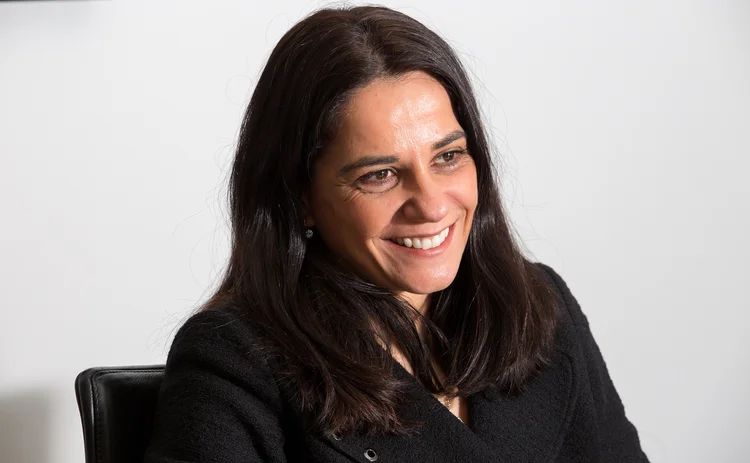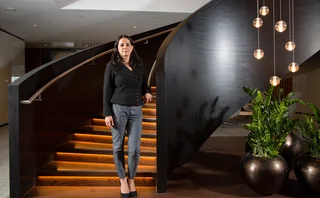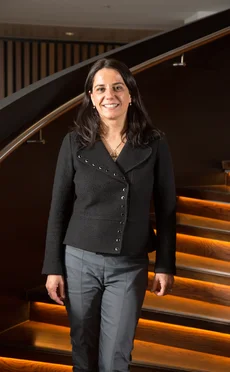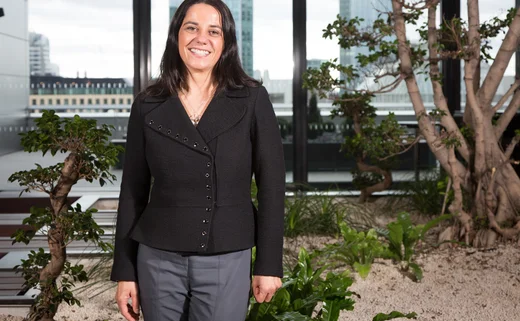Bea Martin: The Glue That Bonds UBS
In the April 2018 cover story of Waters, UBS Investment Bank's COO, Beatriz Martín Jiménez, talks with Victor Anderson about blockchain, AI and some of the hurdles she has faced in her career.

We’re in the heart of UBS’ new London premises, 5 Broadgate, a building that oozes cool sophistication and restraint of which the Bauhaus principals would surely have approved, given its capturing and clear definition of space that its designers, Make Architects, so cleverly construed. It’s March 8—International Women’s Day—and Waters is meeting with Beatriz Martin Jiminez, the COO of UBS Investment Bank. Bea Martin, as she is known, joined the firm in 2012 as chief of staff to president of the Investment Bank, Andrea Orcel, during a period of unprecedented upheaval for the 155-year-old institution.
“When I took the role with Andrea as his chief of staff, I was focused on the separation of the good bank from the bad bank,” she recalls. “As his chief of staff, I was very active in helping him with that.”
Martin’s transition from the firm’s chief of staff to its COO role coincided with the metamorphosis that the role had been undergoing for a number of years. “I would say, 10 years ago, half the investment banks on the Street didn’t even have a COO, and if they did, it was probably more of an operations person,” she says. “The scope of the role has changed over the last five years, and for us it is there to enable the businesses to implement their strategy.”
Coal Face
As one might expect, Martin paid her dues at the coal face, starting her career as a graduate trainee at Deutsche Bank in 1996. From 1996 to 2004 she held a number of roles in structuring and trading at the German bank, both in London and in its Frankfurt headquarters. From 2004 to 2009 she was managing director and head of Iberia fixed-income sales, having been promoted from executive director in 2007. Her next move was from Deutsche to Morgan Stanley where she was head of European fixed-income bank solutions and a member of the interest-rate and credit operating committees from 2009 to 2011, before finally joining the UBS ranks in November 2012, the stopes, a distant memory. “I was in front-office roles throughout my career and I came to UBS to be the chief of staff for Andrea just as the bank was about to announce its big restructuring and the acceleration of its strategy,” Martin says.

She explains that UBS had long considered what to do with the investment bank—it was, she says, consuming a lot of capital and the returns were sub-optimal when compared with other parts of the business. A cursory glance in the rearview mirror reveals the scale of the losses suffered by large numbers of capital markets firms in the wake of the US subprime mortgage fiasco and ensuing global financial crisis, and in that respect, UBS is just another name in a litany of casualties. And then there was the Kweku Adoboli rogue-trading affair in 2011, where the bank incurred losses in the region of $2 billion in its Global Synthetic Equities Trading team. Given that Martin joined UBS 18 months after the Adoboli incident, she clearly had her work cut out for her, but who better to help steady the ship than a battle-hardened veteran with hands-on experience?
The decision was taken by management to reduce the scope of the firm’s trading activities, particularly in fixed income. “UBS went through a tough time after the [global financial] crisis and, due to regulation in recent years, fixed income has been one of the sectors where the investment bank and other banks too have been forced to consume more capital and have been exposed to more liquidity and infrastructure costs. Over time, we looked to decide what to do with the fixed-income business and also bravely define what we are not going to do. The implementation of that was fast—it was painful but it was fast. We repositioned the bank to where we knew we could compete. And where we could compete, we wanted to win, but we would also exit those sectors, products and clients where we were not a top player in the market.”
Upper Echelons
Inevitably, our conversation meanders its way toward the fact that Martin has risen to the upper echelons of one of the largest investment banks in the world in an industry that is undeniably a white, male-dominated environment. As an example of success in this space, there must have been challenges that needed to be addressed along the way, right?
Martin considers the question and pauses before answering. “As a woman, you have a lot of challenges anyway when you work in the capital markets—it’s been a man’s world and that is a fact,” she confirms. “As a woman, you see things differently, but for me it hasn’t been a great issue. I’ve never felt that I couldn’t do anything during my career because I am a woman. To me, one of the biggest challenges continues to be juggling family and everything outside of work with work. No matter how progressive your husband or partner might be, in reality, it is very difficult to let go of all that. In theory, everybody is happy to have a certain infrastructure around those things, but when worse comes to worst, that responsibility is with you [as a woman]. For women, that is an extra burden that men tend not to have in their working life.”
Undeniable Differences
Given that the subject had now been broached and that both interviewer and interviewee are (apparently) comfortable with the conversation’s bearing, it seems appropriate to quiz Martin on the sometimes subtle yet undeniable behavioral differences between men and women and their management styles, most notably those pertaining to people management. Anecdotal and empirical evidence suggests that women are more comfortable and skillful and therefore more effective when it comes to managing people than their male counterparts, a subject Martin is happy to address.

“I’m talking in generalities here, but I do think women are often better at connecting the dots,” she explains. “I think women’s emotional quotient (EQ) is probably higher [than men’s]; they can read people better, and generally, women observe more than men do. They also tend to have more empathy. With a woman leader, it’s easier to get everyone’s perspective in a room and to be more inclusive because they tend to feel less challenged. So I feel there are a lot of advantages in terms of real returns of having women in senior positions.”
It is no secret that UBS has a number of women in its upper strata—Sabine Keller-Busse, group COO of UBS, and Kathryn Shih, president of UBS Asia-Pacific, are part of the bank’s executive committee, and four women sit on the UBS board. Is that purely circumstantial and down to the fact that it just so happens to have a large number of particularly talented women, or does UBS have a formalized mechanism designed to identify women and ensure that it maximizes their potential by fast-tracking them to executive positions? “It is both,” Martin confirms. “I think we do have a lot of very good women within this organization, but it is also true that we have thought a lot about how to create a framework to ensure that we can identify, develop and retain that talent, explicitly for diversity and for women.”
Banking on Technology
On the technology front, Martin explains that part of her remit requires daily interaction with the Investment Bank’s CTO, while the business and technology arms run the budget collaboratively, allocating capital to the firm’s various divisions, aligned with the strategies and returns it anticipates it will make based on its technology commitments. “He is in charge of ensuring that we have the right people in the right places, marshaling the programs and doing the development that needs to be done,” Martin explains. “And I, together with the business, direct the investment into the places we think we need to. In the last few years we have separated that investment into two buckets: one, the growth strategy of the bank, and two, the regulatory bucket, which has obviously been consuming a lot of time and money.”
What will UBS look like in five to 10 years’ time, given that the sell side is inexorably moving toward and fully embracing technology to the extent that a number of firms—Goldman Sachs and Saxo Bank for example—already consider themselves first and foremost to be technology firms that offer their clients various financial services as opposed to capital markets firms with a heavy reliance on technology? “I think we are now more reliant on technology than ever before and the business in five years will be very different [to what it looks like now],” Martin believes. “It was very different five years ago. This industry is changing at a huge pace and I do think that we will make use of technology to make those changes. But are we going to be another Google? Personally, I don’t think so—I don’t think we’re going to turn into a pure technology company—but we will be much more technology dependent and we will be much more innovative in terms of what we do with technology than we are now.”
Incomplete
Any discussion that centers on technology from a capital markets perspective would be incomplete without mentioning the industry’s two hottest topics: blockchain and artificial intelligence (AI). But before Martin dives in, she cites UBS’ Neo institutional front-office platform as an achievement the Swiss firm is particularly proud of. Of course, UBS Delta, a portfolio analysis and risk management offering that formed part of the Neo suite, was also a crown jewel before it was unexpectedly sold to London-based buy-side technology provider StatPro in April 2017. Both Neo and Delta are well known to Waters—both have won awards, with Neo taking home the best cross-asset trading initiative in the 2016 American Financial Technology Awards, while Delta won the best broker-supplied tool and best overall technology provider to the buy side in the Buy-Side Technology Awards of the same year.

“We have been developing Neo for the past eight years,” Martin says. “I think it’s a unique way to deliver a lot of banking services to institutional clients. When you look at a lot of the innovation that is happening in the investment bank, much of it is happening within the businesses, and I think that is the right way for it to happen. These guys will experiment and do proofs of concept to see what techniques they can apply, whether it is big data analytics or AI in order to work smarter and be more productive in the way they do things.”
Martin explains that UBS is still experimenting with blockchain and is evaluating possible applications of the technology and how those use-cases might affect the wider industry. That blockchain will shape the capital markets in one way or another is not worth debating—that is a given. But what is less certain and what UBS is focusing on—along with most other capital markets firms right now—is how and when that change might transpire.
According to Martin, UBS has a number of employees working at Level39—in 2015 UBS started what it calls a “path-finding” journey through its UBS Innovation Lab located within the Level39 environment, a Canary Wharf-based fintech ecosystem inhabited by fintech firms and mentors, which acts as an incubator and accelerator for startups—who are experimenting with blockchain and are looking at ways to implement it into the bank’s existing processes. “I think the most mature idea for blockchain will be for settlements and the ability to ensure that you can transact and have instantaneous and irrevocable ledger entries,” she says. “Counterparty risk will be eliminated and settlement costs will be reduced. If you can do that and you can do smart contracts, for example—things that will be pre-coded to be enforced under certain circumstances—or if you can do, say, smart securities that will support the whole lifecycle, that will be revolutionary.”
Artificial Intelligence
And what of the other darling of the capital markets right now: AI? The technology has been knocking around the industry for the best part of two decades, underpinning basic algorithmic and smart-order routing tools that have evolved into an indispensable part of pretty much every capital markets firm’s front office. “We’ve been applying simple AI for many years with algo trading in the front office and any strategy that can learn about what the deviations will be, for example, when you see standard deviations more than what you were predicting, and then adjusting the trading pattern or strategy to reduce the amount of error,” Martin explains, adding that the technology per se will not bring about a revolution, but rather how it is applied to firms’ existing processes, especially when it comes to deriving value from large, unstructured datasets, an unfeasible proposition just a few years ago.
“If you have enough data and you can mine that data and do something meaningful with it, you can start predicting whether clients will be interested in various products, and which clients will give you a higher rate of success,” she says. “Then you can embed that into people’s desktops to ensure that they are more productive when they pick up the phone. AI is all about the quality of the data you have, but in my opinion, we are never going to be able to leave those decisions to an algorithm—we will still need a human being to be part of that.”
Her Secret Sauce
And a final word from Martin before our scheduled time together is up and she is whisked off with typical Swiss efficiency to another clinical, gleaming wing of this elegant groundscraper to fire up the troops. What is her secret sauce? What does she bring to the role that makes her such an indispensable cog in what is an impressively large wheel? “Being a COO of an investment bank with front-office experience is very valuable, especially as it allows me to understand the business fairly well. My previous role as Andrea’s chief of staff gave me a unique insight and perspective into the priorities of the business, and what needs to get done to win in our endeavor. I have a fundamental knowledge of finance and risk management skills so I truly understand what the back office does as well. The role of COO is just that—to be the glue between the front and back office.”

Further reading
Only users who have a paid subscription or are part of a corporate subscription are able to print or copy content.
To access these options, along with all other subscription benefits, please contact info@waterstechnology.com or view our subscription options here: http://subscriptions.waterstechnology.com/subscribe
You are currently unable to print this content. Please contact info@waterstechnology.com to find out more.
You are currently unable to copy this content. Please contact info@waterstechnology.com to find out more.
Copyright Infopro Digital Limited. All rights reserved.
As outlined in our terms and conditions, https://www.infopro-digital.com/terms-and-conditions/subscriptions/ (point 2.4), printing is limited to a single copy.
If you would like to purchase additional rights please email info@waterstechnology.com
Copyright Infopro Digital Limited. All rights reserved.
You may share this content using our article tools. As outlined in our terms and conditions, https://www.infopro-digital.com/terms-and-conditions/subscriptions/ (clause 2.4), an Authorised User may only make one copy of the materials for their own personal use. You must also comply with the restrictions in clause 2.5.
If you would like to purchase additional rights please email info@waterstechnology.com
More on Emerging Technologies
Bank of America and AI, exchanges feud with researchers, a potential EU tax on US tech, and more
The Waters Cooler: Broadridge settles repos in real time, Market Structure Partners strikes back at European exchanges, and a scandal unfolds in Boston in this week’s news roundup.
Bloomberg rolls out GenAI-powered Document Insights
The data giant’s newest generative AI tool allows analysts to query documents using a natural-language interface.
Tape bids, algorithmic trading, tariffs fallout and more
The Waters Cooler: Bloomberg integrates events data, SimCorp and TSImagine help out asset managers, and Big xyt makes good on its consolidated tape bid in this week’s news roundup.
DeepSeek success spurs banks to consider do-it-yourself AI
Chinese LLM resets price tag for in-house systems—and could also nudge banks towards open-source models.
Standard Chartered goes from spectator to player in digital asset game
The bank’s digital assets custody offering is underpinned by an open API and modular infrastructure, allowing it to potentially add a secondary back-end system provider.
Saugata Saha pilots S&P’s way through data interoperability, AI
Saha, who was named president of S&P Global Market Intelligence last year, details how the company is looking at enterprise data and the success of its early investments in AI.
Data partnerships, outsourced trading, developer wins, Studio Ghibli, and more
The Waters Cooler: CME and Google Cloud reach second base, Visible Alpha settles in at S&P, and another overnight trading venue is approved in this week’s news round-up.
Are we really moving on from GenAI already?
Waters Wrap: Agentic AI is becoming an increasingly hot topic, but Anthony says that shouldn’t come at the expense of generative AI.








